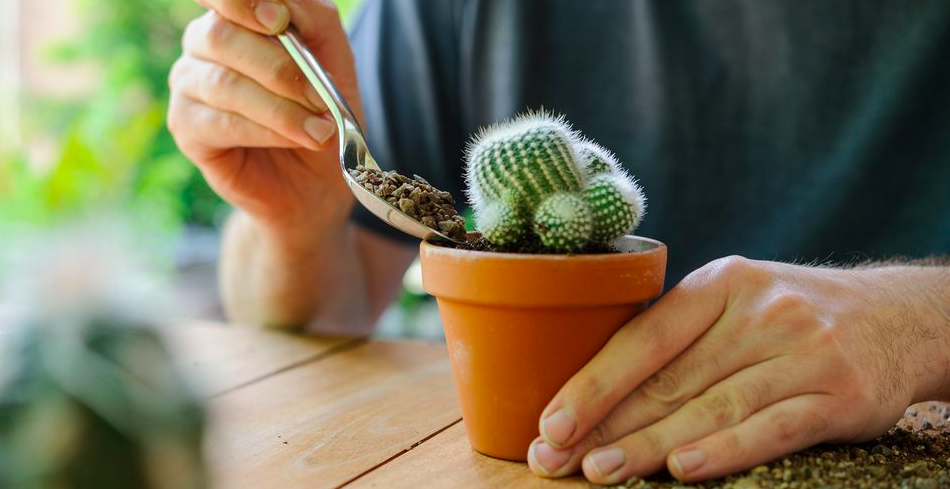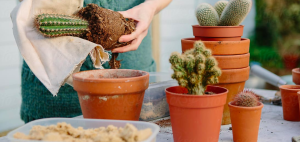
"Taking Care of Cactus (Cacti)".
Caring for a cacti is a unique and straightforward process. Here are some general guidelines to keep your prickly friend happy and healthy:
Light for Cacti:
Light is a critical factor in the care of cactus. Here are more details about providing the right light conditions for your cacti:
Sunlight:

- Cactus are native to arid regions and thrive in bright, indirect sunlight. Place your cacti where it receives at least 6 hours of sunlight per day. A south or west-facing window is usually the best choice.
Intensity:
- While cactus love sunlight, intense, direct sunlight for extended periods can sometimes lead to sunburn. If you move a cacti from a lower light environment to a sunnier spot, acclimate it gradually to prevent stress.
Seasonal Adjustments:
- During the growing season (spring and summer), cactus benefit from more sunlight. In the winter, when many cacti go dormant, they may require slightly less intense light. However, they still need a good amount of light even during the dormant period.
Astonishing Medical advantages of Consuming Cactus Blossoms
Artificial Light for Cacti:

- If natural sunlight is limited, you can supplement it with artificial light. Use a full-spectrum grow light designed for cactus and succulents. Keep the light source about 6 to 12 inches away from the plants and provide 12 to 16 hours of light per day.
Rotation:
- To ensure even exposure to light, rotate your cacti periodically, especially if it tends to lean toward the light source.
Protecting from Harsh Conditions:

- While cactus are adapted to harsh conditions, some may need protection from extremely intense sunlight, especially if you live in a hot climate. Consider providing filtered sunlight during the hottest part of the day or using sheer curtains to diffuse the light.
Remember that the specific light requirements can vary depending on the type of cacti you have. Observing your cacti and adjusting its light exposure based on its response will help you determine whether it's getting the right amount of light.
Watering:

Proper watering is crucial for the health of your cacti. Here are some guidelines to help you water your cacti effectively:
Frequency:
- Cactus are adapted to arid environments and prefer infrequent but deep watering. Allow the soil to dry out completely between waterings. The frequency will depend on factors such as the type of cactus, the size of the pot, the temperature, and the humidity of your environment.
Watering Technique:
- When you water, do so thoroughly, allowing water to penetrate the root zone. Water until it starts to drain out from the bottom of the pot. Discard any excess water collected in the saucer to prevent waterlogging.
Seasonal Adjustments:
- During the active growing season (spring and summer), cactus generally require more water. In fall and winter, when they are often in a dormant phase, reduce the frequency of watering.
Soil Moisture Check:
- Before watering, check the moisture level of the soil. Stick your finger into the soil up to the first knuckle. If it feels dry, it's time to water. If it's still moist, wait a few more days before checking again.
Water Quality:
- Use room temperature water, and avoid using water that is excessively hard or soft. Rainwater or distilled water is ideal, but tap water that has been allowed to sit for a day to let chlorine evaporate can also be used.
Preventing Overwatering:
- Overwatering is a common issue that can lead to root rot. Ensure that the pot has drainage holes, and never let your cactus sit in standing water. If in doubt, it's better to underwater than overwater.
10 Killer Tips to Overcome Depression (To Not Get Depressed)
Dormancy Period:
- Some cactus go through a dormant period, especially in winter. During this time, they require less water. Be cautious not to overwater during dormancy.
Adjust to Environment:
- Environmental factors such as temperature and humidity can influence the water needs of your cacti. Adjust your watering schedule accordingly, especially during extreme weather conditions.
Observation of Cacti:
- Pay attention to the appearance of your cactus. If it looks shriveled, it may need more water. If it becomes discolored or shows signs of rot, it might be getting too much water.
By paying close attention to your cacti and adapting your watering routine to its specific needs, you can help ensure that it thrives and remains healthy.
Soil:

Choosing the right soil is crucial for the health and well-being of your cacti. Cactus are adapted to arid environments, and they thrive in well-draining soil. Here are some tips on selecting and preparing the right soil for your cactus:
Well-Draining Mix:
- Use a specialized cactus or succulent potting mix, or create your own by mixing regular potting soil with perlite, coarse sand, or pumice. Aim for a mix that allows water to drain quickly, preventing waterlogged roots.
Components for Homemade Mix:
- A typical mix for cactus might include two parts of potting soil and one part of perlite or sand. Some people also add small gravel or crushed granite to enhance drainage.
Avoiding Heavy Soils:
- Cactus generally do not do well in heavy, moisture-retaining soils. Avoid mixes with high amounts of organic matter that can compact over time, leading to poor drainage.
Container with Drainage Holes:
- Use a pot with drainage holes to ensure excess water can escape. This helps prevent waterlogged soil, which can lead to root rot.
Repotting:
- Repot your cacti every 2-3 years or when you notice that the soil has become compacted. This provides an opportunity to refresh the soil and inspect the roots.
pH Level:
- Cactus generally prefer slightly acidic to neutral soil. Most commercially available cacti mixes are formulated within the appropriate pH range. However, if you're creating your own mix, ensure that it falls within the preferred pH range of 6.0 to 7.0.
Avoiding Fertilizer in the Soil:
- Cactus are not heavy feeders, and too much fertilizer can harm them. It's generally better to use a diluted, balanced fertilizer during the growing season rather than incorporating it into the soil.
Observation:
- Regularly observe the condition of the soil and the cacti. If the soil stays wet for an extended period or if you notice signs of overwatering, consider adjusting the mix or watering routine.
Remember that different species of cactus may have slightly different soil requirements, so it's a good idea to research the specific needs of your particular cacti. Providing the right soil conditions is a key factor in promoting healthy root development and overall plant vitality.
Container:

Choosing the right container for your cactus is essential for its overall health and well-being. Here are some tips on selecting and maintaining an appropriate container:
Drainage Holes:
- Use a pot with drainage holes at the bottom. Proper drainage is crucial for preventing waterlogged soil and root rot. If you have a decorative container without drainage holes, consider using it as a cachepot. Place the potted cacti inside and remove it for watering, allowing excess water to drain away.
Sleeping Immediately After Dinner Causes Great Harm to the Body
Size:
- Select a container that is appropriate for the size of your cacti. Cactus generally prefer slightly cramped conditions, so choose a pot that is only slightly larger than the diameter of the cacti. This helps prevent overwatering and provides stability to the plant.
Material:
- Choose a container made of breathable materials such as terra cotta or other porous ceramics. These materials allow air to circulate the roots and help excess moisture evaporate.
Weight:
- Consider the weight of the container, especially if you plan to move the cactus frequently. Some materials, like lightweight plastic or fiberglass, are easier to handle than heavier materials like ceramic or stone.
Aesthetics:
- While functionality is crucial, aesthetics also matter. Choose a container that complements the appearance of your cacti and fits well with your home decor.
Elevate the Pot:
- Place the pot on feet or small blocks to ensure proper airflow underneath. This helps prevent the bottom of the pot from sitting in any water that may collect in the saucer.
Inspect for Pests:
- Before repotting your cactus into a new container, inspect it for pests. Ensure that the new pot is clean and free of any potential pests or diseases.
Repotting:
- Repot your cactus every 2-3 years or when you notice it has outgrown its current container. This provides an opportunity to refresh the soil, check the roots, and transfer it to a slightly larger pot if necessary.
Remember to consider the specific needs of your cacti species when selecting a container, as different varieties may have slightly different preferences. The right container, combined with proper soil and watering practices, contributes to a healthy and thriving cacti.
Temperature:

Cactus are generally hardy plants adapted to arid and semi-arid environments, and they can tolerate a wide range of temperatures. However, providing the right temperature conditions will contribute to the overall health and well-being of your cacti. Here are some temperature-related considerations:
Ideal Temperature Range:
- Most cactus prefer temperatures between 70°F to 100°F (21°C to 38°C) during the day. Many cacti can tolerate higher temperatures, but it's important to provide some relief from intense, direct sunlight during extremely hot periods.
Nighttime Temperatures for cacti:
- Cactus often experience cooler temperatures at night in their natural habitats. While they can tolerate some temperature drops, it's generally advisable to keep nighttime temperatures above 50°F (10°C) to avoid stress.
Pain-free normal baby delivery. What are the benefits of this process?
Winter Dormancy:
- Some cactus go through a dormant period in the winter, during which they require cooler temperatures and reduced watering. While they can tolerate brief exposure to near-freezing temperatures, it's generally better to keep them above 50°F (10°C) during this period.
Protection from Frost:
- Most cactus are sensitive to frost, which can damage or kill them. If you live in an area with cold winters, protect your cacti from frost by bringing it indoors or providing some form of insulation.
Temperature Extremes:
- While cactus are adapted to survive in harsh conditions, extreme temperature fluctuations can stress them. Avoid placing them in locations where they might be exposed to sudden temperature extremes, such as close to radiators, air conditioning vents, or drafty windows.
Indoor Temperatures:
- When growing cactus indoors, try to replicate their natural temperature conditions. They do well in typical indoor temperatures, but make sure to provide adequate light, as they still need bright, indirect sunlight.
Acclimatization:
- If you are moving a cacti from one temperature extreme to another, acclimate it gradually to prevent shock. For example, if bringing an indoor cactus outside for the summer, gradually introduce it to increasing amounts of sunlight over a period of a few days.
Monitoring:
- Regularly monitor the temperature conditions around your cactus, especially if it's kept outdoors. Be aware of any sudden changes in weather and make adjustments accordingly.
By providing a temperature range within the preferences of your specific cactus species and protecting it from extreme conditions, you'll help ensure the health and longevity of your prickly friend.
Fertilizing:

Fertilizing is an important aspect of cactus care, although these plants generally do not require as much fertilizer as some other types of plants. Here are some guidelines for fertilizing your cacti:
Frequency:
- Cactus are not heavy feeders, and over-fertilizing can be harmful. During the growing season (spring and summer), you can fertilize your cactus approximately once a month. In fall and winter, when many cactus go dormant, it's advisable to reduce or stop fertilizing.
Type of Fertilizer:
- Use a balanced, water-soluble fertilizer formulated for cacti and succulents. Look for a fertilizer with an NPK (nitrogen-phosphorus-potassium) ratio that is relatively balanced, such as 10-10-10 or 7-7-7. Alternatively, you can use a specialized cactus fertilizer.
What kind of complications can happen to mother and baby due to high blood pressure in pregnancy?
Dilution:
- Always dilute the fertilizer to half or even a quarter of the recommended strength. Cactus are adapted to nutrient-poor soils, and too much fertilizer can lead to salt buildup and damage the plant.
Application Method:
- Apply the diluted fertilizer to damp soil. Avoid fertilizing dry soil, as this can increase the risk of fertilizer burn. Watering the soil before applying fertilizer helps distribute the nutrients more evenly.
Avoiding Fertilizer on Dry Soil:
- Never apply fertilizer to completely dry soil, as it can lead to fertilizer burn. Water the soil first, and then apply the diluted fertilizer.
Timing:
- Fertilize in the morning or early evening when the temperature is cooler. This helps prevent the fertilizer from evaporating quickly and reduces the risk of burning the plant.
Cease Fertilizing During Dormancy:
- Many cactus go through a dormant phase in the winter when they require less water and nutrients. During this time, it's advisable to reduce or stop fertilizing until the growing season resumes.
Observation:
- Watch for any signs of over-fertilization, such as yellowing or browning of the cacti, which may indicate that you need to reduce the frequency or strength of your fertilizer.
Remember that the specific fertilizing needs may vary depending on the type of cacti you have, so it's a good idea to research the particular requirements of your specific species. Adjusting your fertilizing routine based on the plant's response and overall health is key to providing the right nutrients without causing harm.
Handling:

Handling cactus requires a bit of care and attention due to their spines. Here are some tips for handling cacti safely:
Protective Gear:
- Wear thick gloves when handling cactus to protect your hands from spines. Leather gloves are a good choice, but any gloves that provide sufficient protection against punctures will work.
Use Tools:
- When moving or transplanting cacti, use tongs or specialized cacti-handling tools to avoid direct contact with the spines. This minimizes the risk of injury.
Avoid Touching Spines:
- Refrain from touching the spines with your bare hands. Even tiny, seemingly harmless spines can cause irritation and discomfort.
Hold the Cactus at the Base:
- When you need to pick up or move a cacti, grasp it firmly at the base, away from the spines. Be careful not to squeeze too tightly, as some cactus can be more fragile than they appear.
Learn the Symptoms of Gallstones and Useful Information
Work Slowly and Carefully:
- Take your time when handling cacti. Slow, deliberate movements can help you avoid accidental contact with the spines.
Be Mindful of Surroundings:
- Be aware of your surroundings when handling cacti. Make sure there are no obstacles or people in your way, as you don't want to accidentally bump into something while holding a cacti.
Repotting Precautions:
- When repotting a cactus, use a pair of long-handled kitchen tongs or chopsticks to gently guide the roots into the new pot. This minimizes the risk of injury to both you and the cacti.
Emergency Measures:
- If you do get spines embedded in your skin, use tweezers to carefully remove them. Avoid using your bare hands, as this can result in more spines getting stuck. Clean the affected area with mild soap and water.
Consider Size and Weight:
- Larger cactus can be heavy, so use proper lifting techniques to avoid straining your back or dropping the cacti.
Children and Pets:
- Keep cactus out of reach of children and pets, as the spines can be harmful if ingested or if a curious child or pet tries to touch them.
Remember that some cactus have spines that can cause skin irritation or be difficult to remove, so taking precautions is essential. By being mindful and using protective measures, you can handle your cacti safely and enjoy their unique beauty without the risk of injury.
Repotting:

Repotting is an essential aspect of cacti care and is typically done every 2-3 years or when you notice signs that the cactus has outgrown its current container.
https://livewithgreen.com/details-on-taking-care-of-cacti/
.jpg)